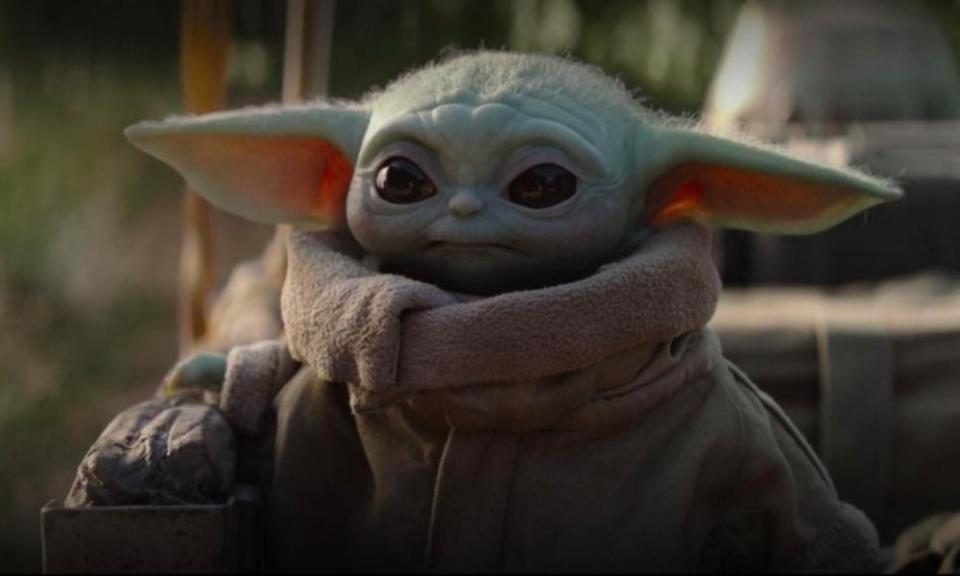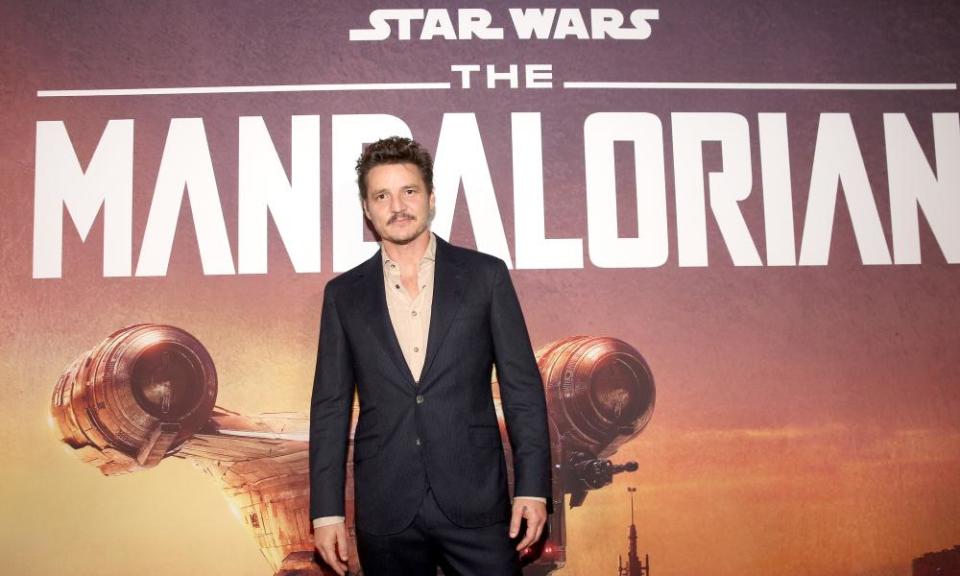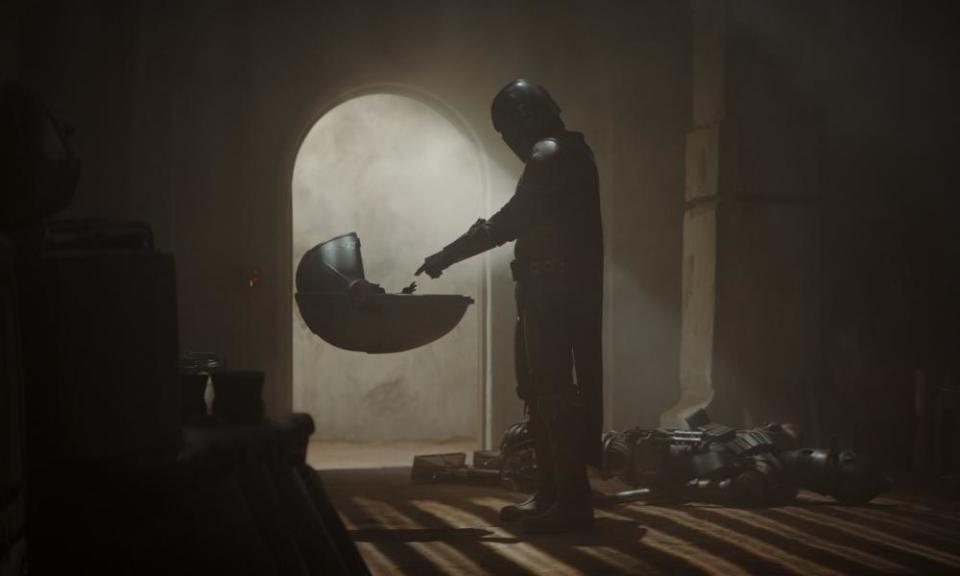Big deal, he is: how Baby Yoda became 2019's biggest new character
Three weeks and four episodes into its run, Disney+’s The Mandalorian – the brand-new streaming service’s flagship series and the first live-action Star Wars show – has already cemented its legacy thanks to the sensation that is Baby Yoda. The mysterious green tyke has been dominating pop culture and social media ever since episode one, while the deployment of The Mandalorian at the start of the holiday shopping season guarantees that related merchandise will be flying off the shelves. The timing also leads directly into the release of the third and final instalment of the franchise’s theatrical saga, ensuring that Star Wars will reign supreme as we close out this decade and usher in the next.
Related: The Mandalorian review – splashy Star Wars show is a dusty disappointment
Suffice to say, Disney’s gamble – The Mandalorian cost about $15m per episode – will end up paying off. Even taking into consideration how ephemeral most pop culture phenomena turn out to be in our oversaturated media landscape, Baby Yoda fever is likely to prove a chronic condition.
Mastery of puppets

Not to take any credit away from The Mandalorian creator and showrunner Jon Favreau, but the idea of an infant-sized Yoda is brilliant only in its obviousness. Indeed, this marks the third time Star Wars has gone to that particular well: The Phantom Menace gave us a precocious, toe-headed Anakin Skywalker, while the animated series Star Wars: The Clone Wars introduced Rotta the Hutt, the pint-sized offspring of Jabba the Hutt. Neither of those examples set the world on fire (well, Anakin did, but not in the way Lucas intended), so credit for the Baby Yoda phenomenon lies squarely with the designers and technicians responsible for bringing him to life.
Like his older namesake, Baby Yoda is an animatronic creation operated by a team of puppeteers. It’s the tactile – and at times uncanny – nature of the thing that is responsible for people’s visceral reaction to it, and it doesn’t seem too early to place it in the same pantheon of beloved practical creature creations as ET, Mogwai or the original Yoda. Even the most cynical observer has to admit: the puppet is objectively beautiful. If it can move as stoic and fatalistic a figure as Werner Herzog to tears, what chance did the rest of us ever stand?
Fan theories
As no doubt many a casual observer has learned firsthand after being corrected by a Star Wars-obsessed family member, friend, co-worker or checkout line eavesdropper, Baby Yoda is not, in fact, a young version of the Yoda we all know. Or, then again, maybe he is?
As soon as his big bat-ears and tiny little head popped out of his floating crib, fans immediately began speculating about his identity and import. The Mandalorian has thus far doled out precious few clues as to the true nature of The Child, as he is referred to within the show. He’s first introduced during the closing moments of the pilot, revealed to be the bounty that our eponymous bounty hunter hero, the equally mysterious Mandalorian (or Mando, as he’s known to friends), was hired to collect, dead or alive. Aside from its gender, we know only that The Child is 50 years old (his species has an exceptionally long lifespan, as first noted in Return of the Jedi when Yoda reveals he’s been alive for 900 years), and that, like the other members of his species we’ve been introduced to in past films, he is Force sensitive.
You’d be forgiven for not remembering when or where we were introduced to other members of his species: in The Phantom Menace, a female Yoda lookalike can be glimpsed in the background of several key scenes taking place inside the chamber of the Jedi Council. Although her name is never spoken in the film, it was later revealed to be Yaddle. She doesn’t appear in any of the other prequels or sequels, so as far as the official canon goes, her fate remains a mystery. The Mandalorian is set five years after Return of the Jedi, which means that The Child was “conceived” sometime during the events depicted in the prequel saga or immediately prior. It is therefore entirely possible that Baby Yoda is the offspring of Yoda and Yaddle. Off-putting as the thought of Yoda getting it on is to most of us (I wish I could say all of us, but a cursory Google search would quickly disabuse me of any such notion), the timeline is too specific to dismiss the possibility outright.
(That said, the prequels also hinted that Anakin Skywalker was the product of a virgin birth by way of midi-chlorian manipulation, so it’s possible that Baby Yoda had similarly miraculous – and similarly bogus – origins.)
There’s also the strong possibility that Baby Yoda is actually Baby Yoda, albeit a copy of the original. Cloning has been a central part of the Star Wars mythology from the very beginning, with Obi-Wan Kenobi mentioning “the Clone Wars” early in the first film. The depiction of that war in Episode 2: Attack of the Clones introduced viewers to the Kaminoans, a secretive and scientific race of master cloners. Their insignia reappears in The Mandalorian, as seen on the uniform of one Dr Pershing, a scientist in league with the show’s central villain, but who seems to have ulterior – and possibly benevolent – motives for wanting to possess the tiny Jedi foundling.
Both theories seem to hold water at the moment, and since Star Wars has always put great emphasis on familial bloodlines and royal lineage, it would be surprising if Baby Yoda turned out simply to be some random orphan caught up in the fallout of the original saga. Doubly surprising, in fact, when you take into consideration the angry fit thrown by a vocal contingent of Star Wars fans after writer-director Rian Johnson pulled that exact reveal regarding the character of Rey in The Last Jedi. Speaking of controversy …
The Baby Yoda Show, featuring The Mandalorian

Fan reaction for The Mandalorian has been almost unanimously positive, which comes as something of a surprising considering how controversial most new Star Wars entries end up. The same can be said of the overwhelmingly welcoming reception to Baby Yoda even from diehard fans, who tend to reject the franchise when it dips into cuteness and/or broad comedy (see: Ewoks, young Anakin, Jar Jar Binks, Porgs). Here though, it seems their hard nerd hearts are just as susceptible to Baby Yoda’s charms as everyone else’s.
Before the introduction of Baby Yoda (whose existence was kept impressively under wraps prior to the series premiere), anticipation for The Mandalorian was somewhat muted, owing possibly to confusion over the premise, with many casual fans assuming it was a Boba Fett origin story. Even without the character’s inclusion, the show would probably have proven popular with Star Wars devotees, but there’s nothing to suggest that it would have been more than a blip on the radar of the larger culture. For as much as people like to compare the show to classic westerns and samurai films, it’s most reminiscent of syndicated adventure series from the 90s, such as Hercules: The Legendary Journeys and Xena: Warrior Princess, albeit with a much larger budget and far superior production design. Combined with its literally faceless cipher of a hero, the show required an additional element for a mass audience to latch on to. Enter Baby Yoda, whose popularity in both the long and short run will end up seeing a return on Disney’s mega-expensive investment. Which brings us to our next subject …
Memes and merch
me looking over the new baby yoda memes every week despite not having seen the show and having no idea what’s going on pic.twitter.com/7TQzwGJIXz
— charlotte nicole davis (@cndwrites) November 30, 2019
I don’t think it’s overly cynical to suggest that The Mandalorian’s creative team intentionally fashioned several of Baby Yoda’s scenes with the express purpose of having them go viral. Initial reports that Disney was actively scrubbing the web of Baby Yoda gifs proved unfounded, and it’s now practically impossible to scroll through any social media platform without being inundated with pics, videos, memes and gifs of the bug-eyed, big-eared tot. Obviously, anything as eye-catchingly adorable as that puppet was always destined to take social media by storm, but still – it’s impossible to look at the shot from Episode 4 of him sipping broth from an oversized mug and not immediately think of the Kermit Sipping Tea meme. (For what it’s worth, that episode’s director, Bryce Dallas Howard, has claimed the response took her by surprise, but you’ll forgive me if I don’t buy that.)
Meanwhile, on the merchandising front, Disney surprised everyone by holding back, at the request of Favreau, the announcement of tie-in toys, apparel and accessories so as to avoid spoiling the character’s surprise reveal, although they have since announced the first round of products just in time for Christmas shopping (much of it having already sold out on Cyber Monday).
What Baby Yoda means for the future of a galaxy far, far away

As to what Baby Yoda entails for Star Wars in and of itself, that remains to be seen. We know that The Mandalorian will have a second season, and, per a recent revelation from Last Jedi director Rian Johnson, we know that Baby Yoda will be in it. While it’s highly unlikely he’ll show up in December’s Star Wars: The Rise of Skywalker, it’s very possible that he, or other characters from the show, will appear in future movies. After all, Disney has let it be known that their slate of upcoming Marvel Universe shows will tie directly into future films, so there’s ample reason to expect the same will be true of Star Wars. Good news for devotees of those franchises, bad news for anyone who thinks standalone movies ought not require homework to follow along.
Speaking of movies: while it’s inevitable that The Rise of Skywalker will do massive box office (the presale numbers having already eclipsed previous franchise records), any worries stemming from the divisive fan response to The Last Jedi or the overall disappointment of Solo can probably be discarded now that Baby Yoda and The Mandalorian have got audiences clamoring for all things Star Wars once more. There’s no telling if the film can best Avengers: Endgame or Avatar (the previous all-time box office record holders, not adjusting for inflation – neither superheroes, Skywalkers nor Na’vi have proved any match for Scarlett O’Hara on that score), although considering all three properties belong to Disney, what could it possibly matter?
The Baby Yoda craze probably means we can expect the Star Wars universe will remain mired in pre-existing iconography, and that it will continue emphasizing the familiar over the new. But this has been the case since the conclusion of the original trilogy, and for as much as people like to malign the prequels, George Lucas was on point in recognizing that the fanbase’s hunger for explication far outweighs their taste for mystery or ambiguity. Lucas himself had previously forbidden any creators working within the Star Wars Extended Universe (offshoot novels, comics, games, etc) from divulging the origins, whereabouts or even the name of Yoda’s species, and although the mere existence of Baby Yoda would seem to contradict this mandate (no longer valid now that the property is out of his hands), it can’t do any worse damage to the character’s legacy than Lucas himself did by turning him into a kung fu fighting CGI monstrosity 17 years ago.
As noted earlier, the true impact of Baby Yoda speaks first and foremost to the hard work and creativity of The Mandalorian’s ace design and effects team. Very few purely digital creations have inspired such widespread and immediate visceral reaction and emotional attachment. Hopefully, the character’s popularity will lead to a greater investment in, and emphasis on, practical effects in large budget studio productions. If that ends up being the real legacy of Baby Yoda, it’s a fair trade-off for oversaturation.

